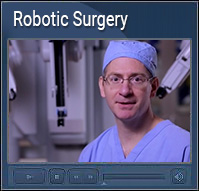Laparoscopic Partial Nephrectomy: In laparoscopic partial nephrectomy, there is not an efficient method to cool the kidney as in open surgery. As a result, tumor resection and kidney reconstruction is ideally limited to 30 minutes from the moment the kidney vessel is clamped lest the kidney suffer irreparable damage. Angle of approach to the tumor matters. It’s important, therefore, for the operating surgeon to be facile with both transperitoneal and retroperitoneoscopic approaches to video telescopic surgery. (In transperitoneal laparoscopy, the kidney tumor is accessed through the abdominal cavity from front to back. In retroperitoneoscopic surgery, the kidney tumor is accessed directly in the flank, which gives better access to the backside of the kidney). Dr. Kaynan is one of only few in the New York Metro Area with this skill set.
daVinci Partial Nephrectomy: Robotics adds additional layers of finesse to the reconstructive aspects which potentially improve accuracy and precious time. Further, it broadens the range of patients who are candidates for a laparoscopic partial nephrectomy. This is now the preferred method for most small kidney tumors being removed, and both transperitoneal and retroperitoneal approaches may be applied. At Morristown Medical Center, we use an Xi model daVinci Surgical Robot for this operation which allows for better range of motion within the abdomen, which amounts to easier dissection and manipulation of the kidney. Intra-operative ultrasound is used to delineate tumor margins. Firefly technology (Near InfraRed Fluorescent Imaging with the use of ICG-dye), similar to night vision goggles, is used to ascertain proper vascular control of the kidney, and to delineate tumor margins. In select circumstances, Firefly technology may facilitate a “Zero-Ischemia” technique of tumor resection, in which essentially only the tumor bed is rendered bloodless during partial nephrectomy and blood supply is maintained to the rest of the kidney. This technique may yield even better preservation of kidney function. Finally, AirSeal insufflation of the abdomen maintains a constant working space, critically important during robotic partial nephrectomy.
The virtues of robotic partial nephrectomy compared with open surgery include:
- Equivalent cancer control
- Potentially less blood loss
- Less pain
- Fewer wound infections
- Shorter hospital stay
- Smaller scars
- Quicker return to activities of daily living (driving a car within 2 weeks instead of 6)
- Quicker overall convalescence (2 months instead of 6)
Note that for the larger, deeper, or central tumors subjected to robotic partial nephrectomy, there is a higher chance of significant bleeding, urinary leak, re-operation, and loss of kidney. Therefore, this approach to kidney tumor resection must be weighed carefully against the other options. The operating surgeon must be facile with all methods of kidney tumor removal, as is Dr. Kaynan, in order to handle this type of surgery.







